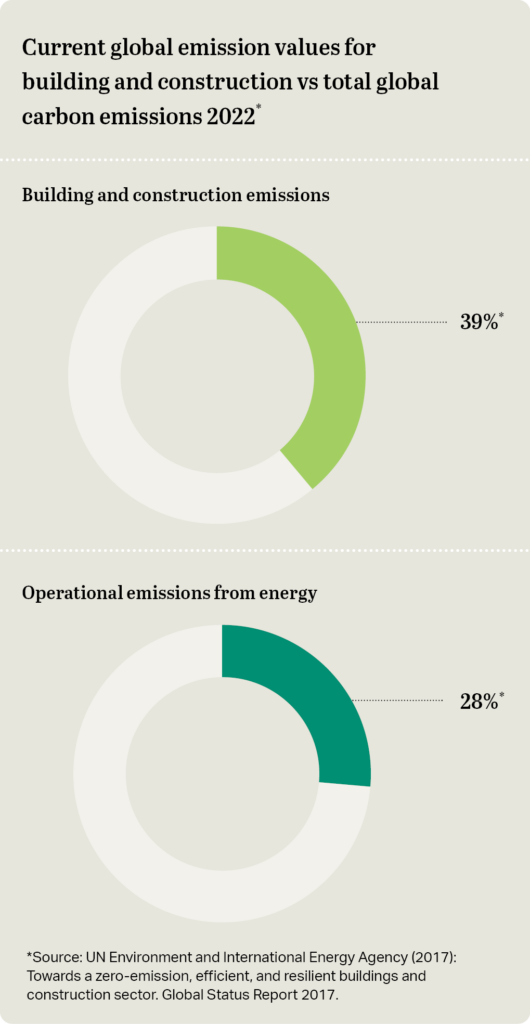Thrive or dive: how choices today can save our buildings and places tomorrow
Together, buildings and construction are responsible for 39 percent of all carbon emissions globally, with operational emissions from energy alone accounting for 28 percent. In this article, we explore how the built environment can transition to net zero and the action needed to improve climate change governance nationally.

The United Nations’ Intergovernmental Panel on Climate Change (IPCC) has sounded the alarm: “Any further delay in concerted anticipatory global action on adaptation and mitigation will miss a brief and rapidly closing window of opportunity to secure a liveable and sustainable future for all.”
The IPCC scenario assessment demonstrates that limiting warming to less than 1.5°C requires global greenhouse gas emissions to peak between 2020 and 2025 at the latest and be reduced by at least 43 percent by 2030. Without radical proactive action, we will not achieve this.
As a key contributor of carbon emissions, the building industry must respond. We need to build flexible, carbon-positive buildings and infrastructure while simultaneously upgrading and adapting our existing assets to drive down our carbon footprint.
Without change, the buildings of yesteryear will not thrive in a net zero society and may become ‘stranded assets’ – one of the biggest challenges facing the property and infrastructure sector today. These buildings will continue to negatively impact our ability to meet carbon targets, and running costs will surge. We must act now to prevent these assets from becoming less desirable to future users and tenants, and less valuable to investors – essentially ‘stranded’.
The transition to renewable energy is often seen as a silver bullet for carbon elimination. However, to achieve the targets set out in the Paris Agreement, which aim to limit global warming to well below 2 degrees Celsius, we need to consider an asset’s whole operational life. Reducing operational emissions requires a multifaceted approach, driving carbon elimination across energy, waste, fuel, refrigerants, water and wastewater, and transport.
Refitting for resilience
An asset that achieves highly sustainable outcomes today may underperform against sustainability principles of the future. For our assets to remain valuable and relevant in a net zero society, we must rethink the design of new buildings and places and how we upgrade existing building stock to serve our changing environmental and societal needs.
Let’s explore how action to eliminate operational carbon. Five key areas can drastically change a building’s resiliency and impact the level of associated risk for owners and investors.
Operational carbon action: compare the pair
Our asset owners, Fred and Yasmin, are making choices today that will impact each building’s carbon emissions and value in the future. Explore the scenarios below:

Why policy must become Australia’s first line of climate defence
Policy and incentivisation play an integral role in education, equity, and mobilisation, and will be vital to quickly achieving carbon targets. History tells us that policy works – addressing knowledge gaps and driving widespread change throughout communities.
Governments across the globe are using policy to shape climate resilience:
- In Canada, the federal government has implemented a carbon pollution pricing system and a 2030 Emissions Reduction Plan.
- The UK government has introduced a policy to stop the sale of internal combustion engine cars by 2030.
- Through its Heat and Building Strategy, the UK has also introduced a £450 million (US$548 million) Boiler Upgrade Scheme to help existing small domestic buildings transition to low carbon heating systems.
In Australia, policies like these are yet to be taken up at a national level. Timeliness is crucial. If the industry waits until policy demands change, we will see a delayed impact in reducing our emissions. We are also likely to see the effect of rapid decision-making. Industry will be forced to adapt quickly, which could create capability gaps, including a lack of training to enable skilled employees to transition out of fossil fuel industries, a lack of readiness in the supply chain to respond to demand, and a lack of supporting infrastructure.
In 2021, Australia ranked number one in the Global Real Estate Sustainability Benchmark results, we were a world leader in sustainable buildings. However, while we might outperform many countries in the built environment, this reflects the top of the market – our most privileged, most incentivised, and most able to act now.
Initiatives need to be driven by bottom-up and top-down approaches. Private developers have put Australia at the forefront of sustainability indexes for the built environment globally, rather than national policy.
To meet standards set out in the Paris Agreement, we need national policies that incentivise change and increase the equity and accessibility of operational carbon asset upgrades for small to medium businesses and investors. Without support, how can asset owners like Fred contribute positively and thrive in a net zero society?
The truth is, it’s crunch time. Our government must align national policies to IPCC recommendations to help decarbonise the built environment across all sectors. With the proper support, we can design and upgrade our buildings and communities to create climate-resilient assets that serve our planet and community.
Eliminating operational carbon is not just good business sense; it’s critical for a liveable future.







